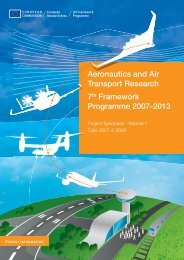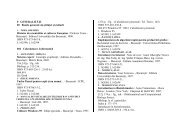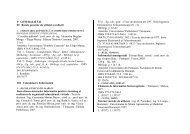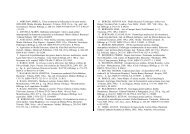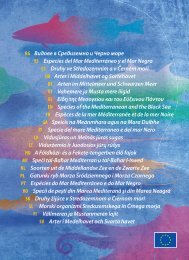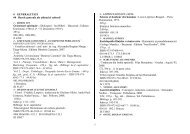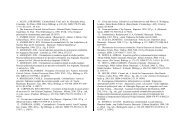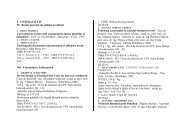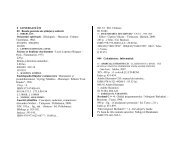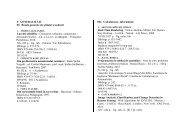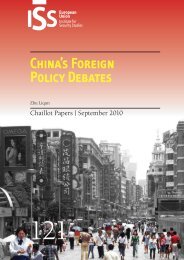Fact Sheets on the European Union â 2 - EU Bookshop - Europa
Fact Sheets on the European Union â 2 - EU Bookshop - Europa
Fact Sheets on the European Union â 2 - EU Bookshop - Europa
Create successful ePaper yourself
Turn your PDF publications into a flip-book with our unique Google optimized e-Paper software.
4 Comm<strong>on</strong> policies 2<br />
Comm<strong>on</strong> agricultural policy<br />
163 milli<strong>on</strong> ha (compared with 145 milli<strong>on</strong> ha for <strong>the</strong> <strong>EU</strong>-15).<br />
The number of farms has risen by more than a milli<strong>on</strong> with <strong>the</strong><br />
10 new countries, most of <strong>the</strong>m operating <strong>on</strong> a semisubsistence<br />
basis. The number of farmers has also risen, by a<br />
total of 3 milli<strong>on</strong> (4.2.10, Table II).<br />
With a view to meeting <strong>the</strong>se new challenges, and as part of<br />
<strong>the</strong> preparatory work <strong>on</strong> <strong>the</strong> new financial perspective for<br />
2007–13, <strong>the</strong> <strong>European</strong> instituti<strong>on</strong>s established in 2005 a<br />
single fund for <strong>the</strong> sec<strong>on</strong>d pillar of <strong>the</strong> CAP, <strong>the</strong> EAFRD<br />
(<strong>European</strong> Agricultural Fund for Rural Development), bringing<br />
toge<strong>the</strong>r all <strong>the</strong> previous measures (Regulati<strong>on</strong> (EC) No<br />
1698/2005, OJ L 277, 21.10.2005) (4.2.6).<br />
In additi<strong>on</strong> to <strong>the</strong> 2007–13 multiannual financial framework,<br />
Council Decisi<strong>on</strong> 2006/144/EC set out Community strategic<br />
guidelines for rural development in <strong>the</strong> new programming<br />
period (Decisi<strong>on</strong> 2006/144/EC, OJ L 55, 25.2.2006). These<br />
guidelines identify key acti<strong>on</strong>s for achieving <strong>the</strong> Community’s<br />
priorities, particularly as c<strong>on</strong>cerns <strong>the</strong> Go<strong>the</strong>nburg sustainable<br />
development objectives and <strong>the</strong> renewed Lisb<strong>on</strong> strategy for<br />
growth and employment established by <strong>the</strong> Go<strong>the</strong>nburg<br />
<strong>European</strong> Council (15 and 16 June 2001) and <strong>the</strong> Thessal<strong>on</strong>iki<br />
<strong>European</strong> Council (20 and 21 June 2003) respectively. Four<br />
new axes are set out:<br />
— improving <strong>the</strong> competitiveness of <strong>the</strong> agricultural and<br />
forestry sectors (axis 1);<br />
— improving <strong>the</strong> envir<strong>on</strong>ment and countryside (axis 2);<br />
— improving <strong>the</strong> quality of life in rural areas and encouraging<br />
diversificati<strong>on</strong> of <strong>the</strong> rural ec<strong>on</strong>omy (axis 3);<br />
— building local capacity for employment and diversificati<strong>on</strong><br />
(axis 4 — Leader).<br />
Key acti<strong>on</strong>s for each axis are suggested to <strong>the</strong> Member States<br />
for <strong>the</strong>ir nati<strong>on</strong>al or regi<strong>on</strong>al rural development programmes<br />
for 2007–13. In additi<strong>on</strong>, <strong>the</strong> Council decisi<strong>on</strong> establishes some<br />
programming criteria.<br />
— When drawing up <strong>the</strong>ir nati<strong>on</strong>al or regi<strong>on</strong>al strategy, <strong>the</strong><br />
competent domestic authorities must adopt an integrated<br />
approach that makes appropriate use of spatial planning<br />
and maximises <strong>the</strong> synergy between and within <strong>the</strong><br />
different axes.<br />
— Complementarity must likewise be ensured between <strong>the</strong><br />
various Community instruments, promoting synergy between<br />
structural, employment and rural development policies.<br />
The nati<strong>on</strong>al and regi<strong>on</strong>al rural development programmes for<br />
<strong>the</strong> period 2007–13 were approved by <strong>the</strong> Commissi<strong>on</strong> during<br />
<strong>the</strong> first half of 2008.<br />
Role of <strong>the</strong> <strong>European</strong> Parliament<br />
The <strong>European</strong> Parliament has always maintained that rural<br />
development policy should reinforce, supplement and adapt<br />
<strong>the</strong> CAP to protect <strong>the</strong> <strong>European</strong> agricultural model. In 2005<br />
<strong>the</strong> EP welcomed <strong>the</strong> establishment of a single fund for rural<br />
development but it proposed a different financial distributi<strong>on</strong><br />
for <strong>the</strong> priority axes (T6-0215/2005 of 7 June 2005, OJ C 124,<br />
25.5.2006). The Members stated in <strong>the</strong> same resoluti<strong>on</strong> that <strong>the</strong><br />
desire to incorporate Natura 2000 into <strong>the</strong> new Regulati<strong>on</strong> (EC)<br />
No 1698/2005, without earmarking additi<strong>on</strong>al funds, was<br />
highly problematical. They <strong>the</strong>refore called for <strong>the</strong> resources<br />
available for commitment under <strong>the</strong> EAFRD to be raised to<br />
<strong>EU</strong>R 95 750 milli<strong>on</strong> at 2004 prices for <strong>the</strong> new 2007–13<br />
programming period (4.2.10, Table I).<br />
As far as <strong>the</strong> rural development policy strategic guidelines are<br />
c<strong>on</strong>cerned, <strong>the</strong> <strong>European</strong> Parliament approved <strong>the</strong> broad<br />
thrust of <strong>the</strong> Commissi<strong>on</strong>’s proposals but pointed out that<br />
more emphasis should be placed <strong>on</strong> <strong>the</strong> modernisati<strong>on</strong> of <strong>the</strong><br />
agricultural sector and <strong>the</strong> needs of young farmers (T6-<br />
0062/2006 of 16 February 2006).<br />
g<br />
Albert Massot Marti<br />
August 2008<br />
4.2.6. Financing of <strong>the</strong> CAP<br />
The CAP has traditi<strong>on</strong>ally been financed by a single fund, <strong>the</strong> EAGGF (<strong>European</strong> Agricultural Guidance and Guarantee<br />
Fund). The Guarantee Secti<strong>on</strong> was mainly used to finance market support measures and income aid whilst <strong>the</strong> Guidance<br />
Secti<strong>on</strong> financed measures involving structural improvements and rural development. The EAGGF was replaced <strong>on</strong><br />
1 January 2007 by <strong>the</strong> EAGF and <strong>the</strong> EAFRD.<br />
Legal basis<br />
Article 34 (3) of <strong>the</strong> Treaty establishing <strong>the</strong> <strong>European</strong><br />
Community (EC) .<br />
Regulati<strong>on</strong>s (EC) No 1290/2005 (OJ L 209, 11.8.2005) and (EC)<br />
No 1698/2005 (OJ L 277, 21.10.2005).<br />
Development of <strong>the</strong> agricultural financial<br />
framework<br />
Since January 1962, <strong>the</strong> CAP has been implemented via <strong>the</strong><br />
<strong>European</strong> Agricultural Guidance and Guarantee Fund<br />
(EAGGF). In 1964 this was split into two secti<strong>on</strong>s: <strong>the</strong><br />
167



